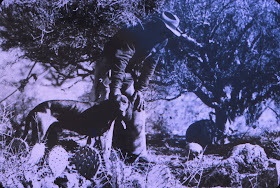I have spent nearly seventy years in the Superstition Mountain area. I first arrived hear with my dad in 1946-47. My dad was always fascinated about the area, because of his best friend Bill Cage. Cage worked at the Christmas Copper Company as a blacksmith. He’d been a blacksmith all his life, and he loved to tell stories about his experiences looking for gold in the Superstition Mountains, as they were called in those days. Today we call the area the Superstition Wilderness Area. When I first worked in the area, they called it the Superstition Primitive Area. This designation was first established in 1939. The Tonto National Forest knew this region as a multi-use for many years.
I was born in 1938, on the eve of this area being designated as such. Also, in April of 1938, the Phoenix Don’s Club dedicated the “Dutchman’s Monument” in Apache Junction at the “Y” intersection for the Apache Trail and then U.S. Highway 60. Highway 60 today is known as the “Old West Highway” and “Superstition Freeway.” How things have changed in the last fifty years or so.
Not too many years ago, I remember George “Brownie” Holmes, talking about the past seventy years of his life and legendary search of the Washington D.C. Dr. Adolph Ruth in the early 1930’s. Well, I can talk like that now. I can remember so many different interesting historical events that occurred in these mountains. The word “history” is defined as a “chronological record of significant events, often with an explanation of their causes.” The word historia is French, but of Greek origin. Most of my writings are very chronological and pay attention to dates.
Yes, George “Brownie” Holmes’ life was a chronological history of the Superstition Primitive Area, the land of “Multi-use”. As I recalled, “Brownie” drove a stage over the Apache Trail, he worked for William Augustus Barkley on the Quarter Circle U for many years, and he searched the Superstition Primitive Area for the Dutchman’s Lost Mine believing until he died in 1980, the mine existed.
 |
| The discovery of Ruth’s skull in December 1931 placed “Brownie” Holmes’ photo in almost every major newspaper in America. |
 |
| I continued my father’s interest, but enjoyed recording the history of the people who lived in this rugged land. Today, July 9, 2018, I will celebrate my 80th birthday. |
Like “Brownie” Holmes, Clayton Worst and others, the secrets of this legendary mine have been kept for more than a century. Bob Corbin gave up his search and now believes the mine was in the Bradshaw Mountains near Prescott. Clay continues to believe it is still out there in the “Wilderness.” Ironically, because of my father and Bill Cage, I have never believed this rich gold mine existed deep in the Superstition Mountains. Yes, lots of gold was mined in the Goldfield area and along the eastern fringe of the Superstition Wilderness Area. Even old Bob Garman found placer gold along Hewitt Canyon, but not enough to make a living on. Bob took me out to Hewitt Canyon and showed me there was placer gold in the area.
I will never find a lost gold mine, because I just don’t believe in them. My real gold is gathering and recording history, and I hope some day it will be valuable to others. I have made my contribution in books I have written, journals I have kept and letters I have collected from all over the world. All of this proves to be a worthwhile “point of reference” to the history of this region.
Yes, I make mistakes, and I hope you research it and find the correct answers. That is what history is all about. I have certainly found my gold of Superstition Mountain.